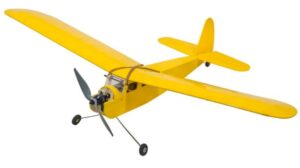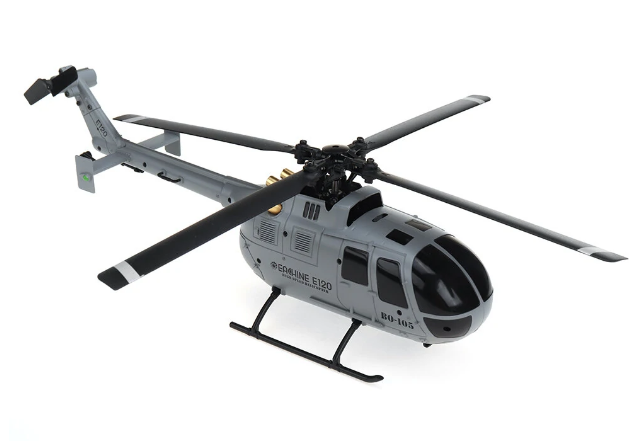
The Busy Dads’ Handbook to the World of Radio-controlled Aircraft
So you’ve been thinking about getting into the world of RC aviation. Maybe it’s the mix of speed and precise coordination that attracts you, or maybe, like me, you like airplanes and helicopters, and looking for some outdoor fun with your kids. Or both.
Either way, buckle up, I’m here to help you take flight!
Let’s start with some background,,,
RC Aviation is Better Than Ever
RC aircraft began to gain popularity in the 1950s with handcrafted Balsa wood planes powered by nitro or gasoline engines. However, recent advancements have revolutionized the hobby, making it far more affordable and accessible.

Today, we have helicopters with stability controls and durable foam airplanes with powerful, long-lasting batteries. Thanks to such innovations, even little kids can enjoy flying these modern RC aircraft.
Basics of RC Aircraft
You don’t need to be an aviation expert to fly an RC aircraft, but it does make sense to know some of the basics, like what they are made of and their main parts…
RC aircraft come in various shapes and sizes, ranging from sleek fighter jets to iconic warbirds and agile helicopters, and from backyard toys to impressive models showcased at aviation events.
RC aircraft are typically made from lightweight materials like Balsa wood and various types of “foam”, such as Expanded Polypropylene (EPP). This makes them highly durable and forgiving, great for beginners and casual flyers.
Advanced hobby-grade models may utilize higher-quality materials like carbon fiber or fiberglass for enhanced performance.
Now, let’s take a closer look at the main components you’ll find on any RC aircraft, whether it’s a plane or a helicopter:
- Fuselage: The main body housing essential components like the battery and motor/s.
- Wings (or Main Rotor Blades): Providing lift and stability.
- Tail Section (Tail Boom in helicopters): Including controls for pitch and yaw in planes, and the tail rotor for yaw in helicopters.
- Control Surfaces: Movable parts such as ailerons and elevators in planes, and cyclic and collective controls in helicopters, which help maneuver the aircraft.

In addition to these components, RC aircraft also have electronic systems such as the receiver and ESC (Electronic Speed Controller). The receiver interprets signals from the transmitter, translating them into commands that control the aircraft’s movements. The ESC regulates the power supplied to the motor, allowing precise control over speed and direction.
Now, to the more exciting part…
Choosing Your First RC Aircraft
If you haven’t already, take a look at the Rookies’ Guide to RC Toy Vehicles to grasp the basics of radio-controlled vehicle toys in general.
If it’s your very first experience with RC aircraft, you may want to start with a simple and fun toy. Look for durability and ease of use, especially if you’re flying with kids.
Beginner-friendly RC Toy Airplanes:
The EPP (‘foam’) 375mm fixed-wing pusher-prop* “SU-35 fighter” EDF* jet, equipped with a brushless motor, offers easy takeoff and landing, assisted flight, and expert maneuvering capabilities.
Check availability:

*EDF stands for Electric Ducted Fan. Though not a true jet engine, it replicates the look and feel of a jet-powered plane.
*Pusher Prop means that the propeller is located behind the wings. This setup protects the propeller better during crashes.

The 400mm wingspan ‘Spitfire Fighter’ (by Eachine) has the Xpilot Stabilization System, perfect for beginners and seasoned flyers alike.
Check availability:
Recommended Toy RC Helicopter:

Check out the Eachine A120 – an awesome-looking 235mm long (10″) RTF RC helicopter with stability control, stall protection, runaway protection, one-key takeoff and landing, and other great features and functions.
Here’s a video featuring this helicopter, packed with invaluable beginner tips:
Beginner Hobby-grade RC Aircraft:
RC toys can be awesome, but, of course, they are limited in terms of speed, size, and maneuverability.
When it comes to size, though the effect on performance is small, having a larger aircraft makes it easier to see from a distance and adds to the enjoyment of watching it fly.
When you feel ready to get more serious into the hobby, it’s time to move up to a ‘beginner hobby-grade RC aircraft’ (sometimes called a “Trainer”).
Look for a model that offers stability, ease of control, and durability.
Assuming you’re a busy dad like me and prefer to keep things simple and easy, I recommend going for a Ready-to-Fly (RTF) model.
RTF (Ready-to-Fly): Fully assembled models that are ready to fly right out of the box. (Though often missing transmitter batteries.)
BNF (Bind-N-Fly): Fully assembled models that require binding to a compatible transmitter before flight.
PNP (Plug-N-Play): Pre-built models that require additional components like a receiver, battery, and transmitter to complete the setup.
One of the go-to websites for this is Hobbyzone.com (RTF Airplanes) >> .
One of the most recommended ‘trainers’ is the 600mm wingspan RTF Arrow Hawkeye >>
Or you can step it out a notch and get the Habu STS 700mm EDF Jet, an RTF Basic Smart Trainer equipped with SAFE technology, ideal for beginner pilots.
See it in action…
Check availability:
If you’re leaning towards helicopters, the RTF 150 FX (by Blade) is hailed as fantastic for beginners and kids, largely owing to its stability control. Plus, its resemblance to a real helicopter (it reminds me of Airwolf if you’re old enough to recall…) adds an extra layer of appeal, in my opinion.

See it in action…
Check availability on Amazon >>
Essential Beginner RC Aviation Tips for a Smooth Take-Off
- Master the Basics: Spend time practicing ground maneuvers and getting comfortable with the controls of your RC aircraft before taking to the skies.
- Simulate Before You Fly: Consider investing in a quality RC flight simulator (such as Realflight >>) to refine your piloting skills in a risk-free virtual environment before flying your RC aircraft.
- Fly Safe! Obtain safety gear such as safety glasses and protective gloves. Before taking off, give your aircraft a once-over to ensure everything’s shipshape. While you’re flying, maintain your focus and awareness, keep your distance from people and obstacles, and have a plan for emergencies.
- Understand Regulations: Familiarize yourself with relevant regulations, such as remote identification (Remote ID) requirements, airspace restrictions, and any local ordinances that may affect RC flying in your area. The Federal Aviation Administration (FAA) provides resources and guidance on regulations for RC aircraft operations. Learn more on the FAA’s website: FAA DroneZone >>
- Join a Community: Engage with other RC enthusiasts by joining a local RC club or online community to gain valuable support, guidance, and opportunities for shared learning and group flying events. (Check out RCGroups.com >>)
- In the US, consider joining the Academy of Model Aeronautics (AMA) >> for added insurance, community support, help in adhering to regulations, and access to resources such as a magazine subscription.
- Maintenance and Care: Proper maintenance is key to keeping your RC aircraft in top condition. Regular cleaning, checking for wear and tear, and storing your aircraft properly can ensure its longevity and performance.
- Explore and Experiment: Once you’ve mastered the basics, experiment with different aircraft models, flying areas, and first-person view (FPV) flying to expand your RC aircraft hobby and enhance your flying experience.
- Check out this video for more helpful tips for beginners in the RC aviation hobby…
Final Note Before You Take Off
As you dive into the world of RC aviation, remember that practice, patience, and safety are your allies.
Whether you’re flying for fun with your kids or just exploring a new hobby, I hope this guide has given you some helpful tips to enjoy the skies with confidence!
I’d love to hear about your adventures on our Facebook page.

